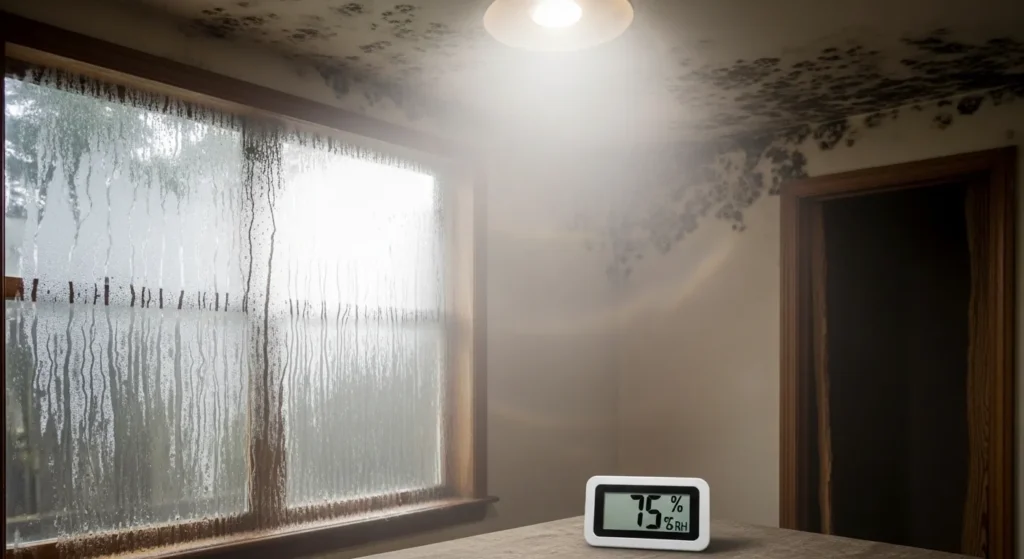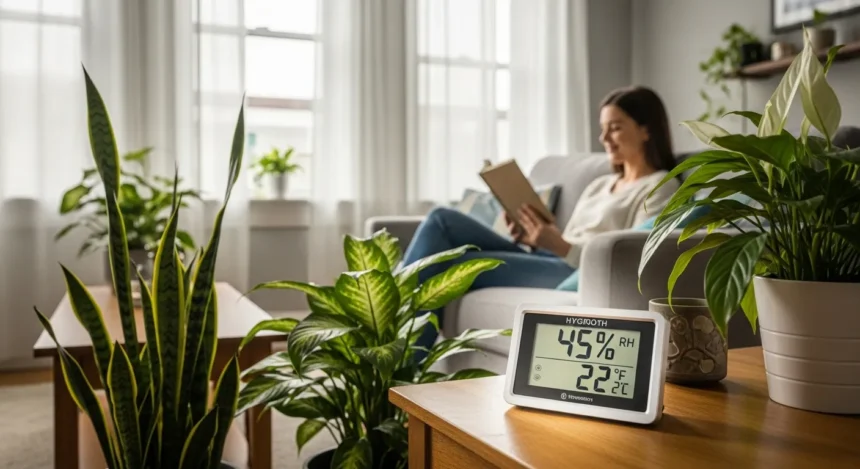Table of Contents
Maintaining normal humidity for a house between 30–50% RH improves health, comfort, and electricity performance. Balancing moisture levels saves you from mold, mildew, dry pores and skin, and wood damage. Using a humidifier, dehumidifier, and proper air flow yr-to-12 months enables you to protect your HVAC system, furniture, and your family in particular. Every man who owns a home must learn how important humidity really is.
Why Regular Humidity Matters for a House
Keeping normal humidity for a house within the advocated variety is simplest, more cushty – it is about safety, financial savings, and fitness.
- Health Benefits: Balanced humidity reduces allergies, bronchial asthma, and breathing problems.
- Structural Protection: Proper RH prevents wood harm, trim warping, and paint chipping.
- Energy Efficiency: When humidity is correct, your heating and cooling systems paint a lot less, saving cash on application bills.
- Case Study: A Naperville, Illinois own family focused on the cost of condensation at the windows and the growing strength in each iciness. After installing the humidifier for the entire house, the man of the house noticed RH stabilized at 35%, putting off the window condensation, and reducing the bills.

Ideal Normal Humidity for a House
The ideal normal humidity for a house is between 30–50% RH according to ASHRAE and Carrier.
- Winter: To avoid frost buildup and dry wintry weather air, target 30-40% which causes dry lips and nostril discomfort.
- Summer: Maintain 40–50% to prevent a clammy air sensation, mold, and short cycling of an oversized AC unit.
Example: In Queensbury, NY (upstate New York), one man uses a dehumidifier every summer to keep less than 50% moisture and keep away from mildew or dust particles within the basement.
Measure the Everyday Humidity
To hold manage, you need to measure RH effectively:
- Hygrometers: Cheap equipment to test RH in minutes.
- Humidistat-Ready Thermostats: Many clever thermostats involve humidity monitoring and allow automatic adjustments.
- Professional Monitoring: HVAC contractors can check the humidity of the entire residence for better power-saving improvements.
Tip: Place hygrometers on each floor, especially in rooms with hardwood flooring, to save your fixtures from racking or electronics from harm. Any responsible man can do this quick check himself.
Risks of Ignoring Normal Humidity for a House
If you forget about the normal humidity for a house, you’re taking risks:
Excess (> 60% RH):
- Fungus, mildew, and bacterial growth
- A clammy air sensation that makes cooling useless
- Wooden swelling and paint chipping
Very Low (< 30% RH):
- Dry skin, static hair, and nose irritation
- Static power buildup is harmful to electronics
- Trim warping and furniture cracking
Real Example: A man with a $5,000 home theater system reported repeated electronics harm because of static discharge. RH remained stable at 40% after installing a cool fog humidifier, preventing further damage.

How to Preserve Normal Humidity for a House
Add Moisture (Winter Solutions):
- Whole-House Humidifier: Best for RH consistently in all rooms.
- Portable Humidifier: Good for the bedroom; choose a hot gauze humidifier or an ultrasonic humidifier for cool operation.
Remove Moisture (Summer Solutions):
- Portable Dehumidifier: Works for the basement and laundry room.
- Whole-House Dehumidifier: Combine with furnace and AC unit for mass control.
Lifestyle Tips:
- Use exhaust fans when cooking or bathing.
- Improve insulation to prevent outside moisture from entering.
- Schedule HVAC system maintenance twice yearly with reliable contractors like Simmons Heating and Cooling.
Any man who follows these steps will have fewer maintenance costs and better air quality.
We’ve got more tips waiting for you in Is the Ikigai Test the Key to Living Longer?.
Energy Efficiency Benefits
Maintaining normal humidity for a house can reduce the energy payments up to 10-15%:
- In winter, higher humidity allows you to set the thermostat a few degrees lower.
- In summer, low humidity allows higher temperature settings without discomfort.
- Balanced humidity prevents oversized AC units from short-cycling, extending equipment life.
This is a man’s simple way to save money year-round.
Lifestyle and Seasonal Adjustment
- Winter: Add gentle moisture to keep away from condensation on windows.
- Summer: Use roof fans to circulate air and assist moisture control.
- Daily Habits: Wipe the bathroom walls after showers, cover pots while cooking, and keep doors closed to contain humidity sources.
Man or woman, these habits help maintain healthy indoor air.
References & Research
- ASHRAE: Recommended indoor humidity requirements (2025 updated)
- EPA: Indoor air quality research – humidity and mold prevention
- Carrier & Energy Services: Humidification and Dehumidification Solutions
- Simmons Heating & Cooling: Professional Guide on Home Humidity Control
Final Thoughts
Maintaining normal humidity for a house is one of the easiest strategies to grow comfort, shield your property, and improve health. By putting RH between 30–50%, you reduce the risk of mold, mildew, dry skin, and costly structural repairs.
Whether you invest in a whole-house humidifier, install a dehumidifier, or simply adopt good habits such as using exhaust fans and monitoring RH with hygrometers, balance is critical. Man or woman, you will breathe easier, sleep better, and save money on energy bills throughout the year.









